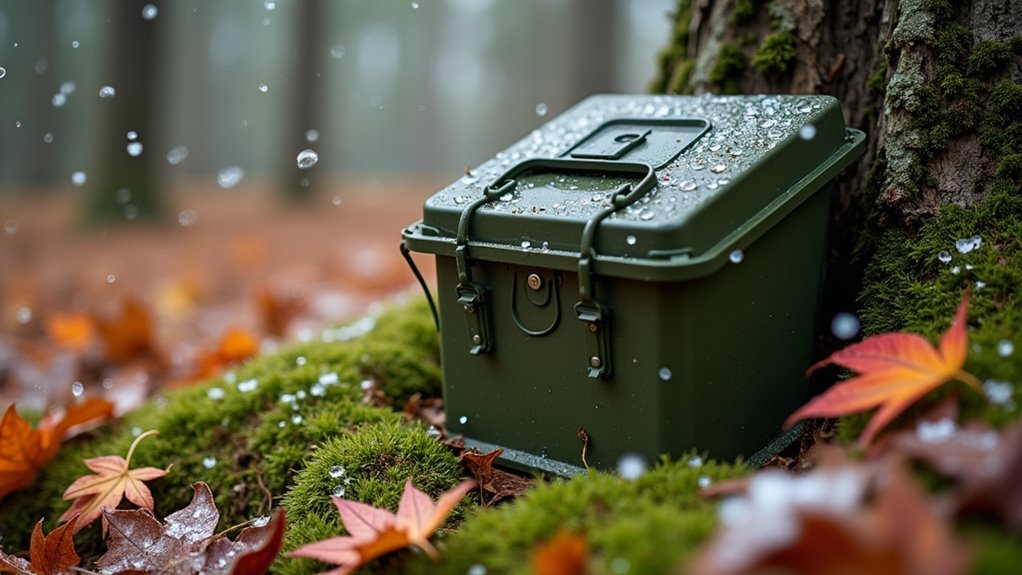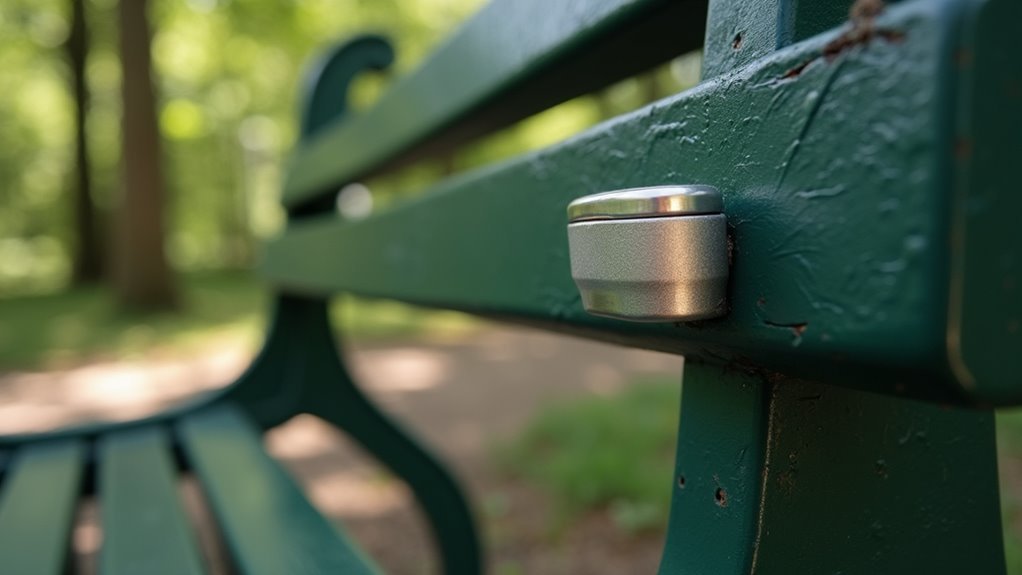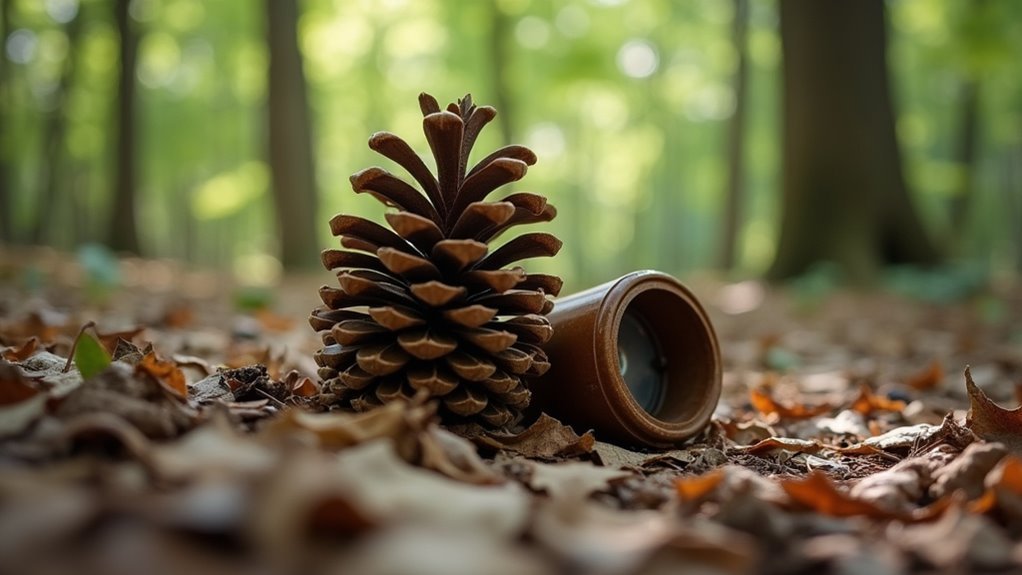Some of the links in this article may be affiliate links. If you make a purchase through these links, we may earn a small commission at no extra cost to you. Thank you.
Last summer, I spent hours hunting for a geocache in the rain, only to find a soggy log sheet inside a deteriorated plastic container. I’ve been on both sides of this disappointing experience, and trust me, choosing the right container can make or break your hide. Whether you’re placing your first cache or your fiftieth, the container you select needs to match your location’s unique challenges. Let me share what I’ve learned about picking containers that will still be intact when finders arrive.
Weather-Resistant Containers for All Seasons

When it comes to protecting your geocache from Mother Nature’s mood swings, choosing the right weather-resistant container is absolutely essential. I’ve found that ammo cans are practically bombproof for hiding a cache in extreme conditions—they’ll stay watertight for years even during flooding!
Ammo cans are the geocacher’s best friend—virtually indestructible and waterproof even when submerged for extended periods.
For a more everyday option, I really like Lock & Lock containers.
They’re fantastic with those airtight seals that keep moisture out no matter the season.
Actually, wait—I meant to say they’re excellent in any climate, not just seasonally.
Before placing your cache, I always recommend the overnight water test.
Just submerge your container and see if it stays dry inside.
Tupperware works well in moderate environments, while those little magnetic nanos with O-rings are perfect for urban spots where you need something discreet yet durable.
Urban Micros: Stealth Options for City Hides
When I’m hiding urban micro caches, I’ve found that small magnetic containers like key holders or bison tubes are my go-to stealth options, especially when they blend with metallic fixtures around the city.
You’ll want to carefully consider your camouflage techniques – I prefer containers that mimic everyday objects, making them practically invisible to the untrained eye (or as we call them, “muggles”).
For successful city placement, I always test my containers under various conditions and maintain proper distance from other caches, which helps guarantee your urban micro remains undiscovered by non-geocachers but findable by those in the know.
Small Magnetic Hide Options
Magnetic hides represent the urban geocacher’s secret weapon in the concrete jungle.
I’ve found that neodymium-based containers offer the perfect blend of security and stealth when you need to place something in plain sight without being obvious.
These strong magnets (I recommend at least 10-pound strength) can hold firm to lampposts or bridge underpasses even in windy conditions.
When I’m setting up a magnetic hide, I typically use nano tubes or small key holders—anything under an inch works best.
You’ll want to make sure whatever you place has proper weatherproofing, though.
Nothing worse than a soggy log sheet!
The real trick, in my experience, is finding that perfect metal surface that muggles won’t notice but fellow geocachers can intuit.
Under benches or on inconspicuous signposts usually works well.
Creative Urban Camouflage Techniques
How do you hide something in plain sight within a bustling cityscape filled with observant passersby?
I’ve found that strong rare earth magnets are absolute game-changers when you place a cache in urban environments.
They let you attach tiny containers like bison tubes to metal surfaces that nobody gives a second glance.
When I hide a cache in the city, I always think about color matching—painting containers gray or black to blend with concrete and steel structures works amazingly well.
You know what’s really effective, though?
Disguising micros as everyday objects like bolts or screws.
I’ve even used hollowed-out artificial rocks tucked under park benches!
The key is keeping containers under 2-3 inches.
Those nano containers are perfect for tight spots like utility box edges—muggles walk right past them!
City Placement Strategy Tips
Where exactly should you place that clever micro cache in a bustling cityscape?
I’ve found that metal surfaces are your best friends—signposts and railings make great locations when you’re equipped with rare earth magnets.
For maximum stealth, try integrating your cache with everyday urban elements.
You know, like hiding it inside a fake bolt or under a bench where it’s technically in plain sight.
Always keep that 161-meter proximity rule in mind! Trust me, reviewers will reject your submission faster than a New York minute if you don’t.
Before finalizing placement, I recommend waypoint averaging—checking coordinates multiple times to get within 5 meters accuracy.
I’ve had caches exposed because, well, I rushed this step once.
Won’t make that mistake again!
Rural and Trail Container Strategies
The great outdoors presents unique challenges when selecting your geocache containers for rural and trail settings.
I’ve found that durability and camouflage are absolutely essential when placing caches in these environments.
In my experience, weather resistance is probably the most important factor—I always test my containers by submerging them overnight to make sure they’ll stay dry during those inevitable rainstorms.
For Geocaching in natural settings, I recommend considering:
- Ammo cans for rural locations where you need protection against moisture and critters
- Lock & Lock containers with earth-tone covers for trails, they’re lightweight but reliable
- Micro containers with strong magnets for those perfect natural place to hide something like under logs or rock crevices
Magnetic Containers: Placement and Durability

Magnetic containers have revolutionized urban geocaching with their incredible versatility and stealth factor.
I’ve found that these little powerhouses, with their rare earth magnets, stick like nobody’s business to metal surfaces around the city.
When I create a cache using magnetic containers, I always look for stable, non-moving metal objects away from high-traffic areas.
Before placement, I actually test them by submerging overnight—you’d be surprised how many fail this simple test!
Nothing worse than getting a “Needs Maintenance” log because your container leaked.
In my experience, these containers hold up beautifully against wind and vibration, but I avoid areas with flooding or extreme temperatures.
The key is finding corrosion-resistant surfaces where your magnetic friend can quietly hide in plain sight.
Premium Containers Worth the Investment
When I’ve invested in premium geocaching containers, I’ve found ammo cans to be absolutely worth every penny for their military-grade durability and weather resistance.
You’ll notice the difference immediately with lockable waterproof options like Lock & Locks, which keep your cache contents pristine even after being subjected to heavy rain or snow.
I think the upfront cost might seem steep at first, but these premium containers typically last years longer than cheaper alternatives, making them more economical in the long run.
Ammo Cans Dominate
Almost every serious geocacher I’ve met eventually invests in quality ammo cans, and I’ve got to say, they’re worth every penny.
When planning your first hide, these military-grade containers provide unmatched durability in harsh weather conditions.
I’ve had ammo cans survive everything from flash floods to curious wildlife encounters without a single drop of moisture reaching the contents.
Why I recommend them before you’ve submitted your cache:
- They’re incredibly spacious, accommodating larger trade items that smaller containers simply can’t handle
- Their lockable design keeps contents secure from animals and accidental discoveries by muggles
- They typically last for years—sometimes decades—with minimal maintenance, unlike plastic alternatives that deteriorate quickly
The natural camouflage potential is another bonus.
In wooded areas, they blend in perfectly while still protecting everything inside.
Lockable Waterproof Options
Serious geocachers understand why I’m so passionate about premium lockable waterproof containers—they’re truly game-changers for long-term cache maintenance.
When you’re creating a cache with high difficulty and terrain ratings, you need reliability that matches the challenge.
Lock & Lock containers have saved countless logbooks in my experience, remaining watertight even after total submersion.
I’ve seen ammo cans still performing perfectly after years in forest environments!
Make sure you test any premium container before deployment though.
I actually—wait, not actually—I simply submerge mine overnight to verify seal integrity.
It’s worth spending a bit more for these lockable options, especially when protecting valuable trackables.
Those padlock-compatible features? They’re not just fancy extras—they’re essential security for high-traffic areas where, let’s face it, muggles might get curious.
DIY Container Ideas for Unique Hides

Why settle for a standard container when you can create something truly memorable for your geocache hide?
I’ve found that transforming everyday items into geocache containers adds that personal touch to your first geocache experience.
Just remember to clearly label it with your GC code and make sure it’s weatherproof!
Here are some of my favorite DIY approaches:
- Repurpose old Tupperware by testing its waterproof abilities overnight (trust me, I’ve learned this lesson the hard way!)
- Create micro caches from empty match boxes with a protective log bag inside
- Attach rare earth magnets to containers for those sneaky metal surface hides
Don’t forget to camouflage your creation!
I usually wrap mine in camo tape or paint them to blend with the surroundings.
Waterproof Solutions for Riparian Zones
Placing geocaches near rivers, streams, or wetlands presents a whole new set of challenges!
I’ve found that waterproofing is absolutely essential for these riparian hides.
In my experience, ammo cans are your best bet – they’re practically bombproof and have passed my overnight submersion tests with flying colors.
Ammo cans reign supreme for waterside caches—virtually indestructible and proven waterproof even when completely submerged.
For smaller hides, I’d recommend Lock & Lock containers with their multiple sealing clips.
They’re what Geocaching HQ often suggests for wet environments.
Wait, no – actually, DBA Geocaching recommends them.
Don’t forget to look for that IP67 rating when flooding is possible.
You know, I’ve had good luck with regular Tupperware too, if you’re on a budget.
Just test it yourself by dunking it overnight.
Those magnetic nano containers with silicone gaskets? Perfect for attaching to metal surfaces in damp areas!
Terrain-Specific Container Selection Guide
The right container for your geocache isn’t just about waterproofing—it’s about matching your hide to the specific terrain where it’ll live.
I’ve found that when someone logs a new find, their experience is greatly influenced by how well the container fits its environment.
In my experience, choosing terrain-appropriate containers makes a huge difference in longevity.
Here’s what I recommend for specific environments:
- Urban areas: Go with small magnetic micros under 5 cm—they’re practically invisible on metal surfaces
- Wet forests: Lock & Locks or ammo cans are your best bet (test them overnight in water first)
- Desert terrain: Use ventilated containers that resist heat while keeping sand out—condensation can be a real problem otherwise
I think of containers as tiny homes for your logbook—they deserve to be chosen thoughtfully!
Container Camouflage Techniques by Environment
A well-camouflaged container can mean the difference between a satisfying geocaching experience and a frustrating one that attracts unwanted attention.
I’ve found that adapting your camouflage strategy to specific environments is essential for success.
In urban settings, I recommend attaching magnetic micro containers to metal lampposts—they’ll blend right in!
For forests, I personally love wrapping Lock & Locks with bark or leaves.
They basically disappear into the vegetation.
Desert caching? Well, painted ammo cans in sandy tones work wonders.
I think waterways require a different approach—covering waterproof containers with local rocks creates natural-looking hideaways.
For park areas, I’ve had great success matching container colors to nearby benches or structures.
The right camouflage technique makes all the difference in different environments!
Maintenance Considerations for Long-Term Hides
Successful long-term geocache hides don’t just happen by accident—they require thoughtful maintenance strategies from the very beginning.
I’ve learned that weather-resistant containers like ammo cans are absolute lifesavers for long-term maintenance.
They’re actually designed to withstand years of punishment from Mother Nature, which means fewer headaches for you down the road.
When I’m planning a cache that’ll stick around, I focus on:
- Testing containers by submerging them overnight (sounds extreme, but trust me, it works!)
- Regularly checking cache logs for finder feedback about potential issues
- Using durable materials like strong magnets for micro caches to prevent them from disappearing
In some areas, like Great Parks, you’ll need to renew your cache annually. It’s a bit of a hassle, but it guarantees your hide remains in good standing with local authorities.
Frequently Asked Questions
Do People Still Geocache in 2025?
Old and new, digital and physical—absolutely! I’ve seen Geocaching Revival continues strongly in 2025, with Participant Trends showing active community engagement through forums, trackable discussions, and experimental features development.
What Not to Put in a Geocache?
I’d never include food, money, or buried items in my geocache. Also avoid toxic items that could harm finders and perishable goods that rot. Everything should remain family-friendly and environmentally safe.
Is Taking Geocaches Illegal?
Yes, I’d consider taking geocaches illegal. It can have serious legal implications including theft penalties, especially if it’s on private property. I always advise reporting issues instead of removal.
What Do C and D Mean in Geocaching?
Over 50% of geocachers check the D/T ratings first! In geocaching, D means Difficulty (finding the cache), while T (not C) means Terrain (physical challenge). These Cache Symbols help you plan your adventure.